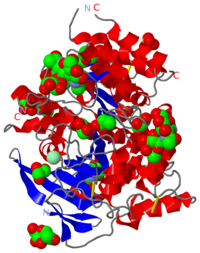Joel L. Sussman Sandbox 1
From Proteopedia
Cationic moieties, such as sidechain nitrogens (lysine or arginine) or metal cations, that are within 6.0 Å of the face of an aromatic ring (phenylalanine, tyrosine, or tryptophan) may engage in polar interactions called cation-pi orbital interactions (cation-π interactions).
Butyrylcholinesterase, also known as pseudocholinesterase, BCHE or BuChE, is an enzyme that, in humans, is encoded by the BCHE gene. Butyrylcholinesterase is also called serum cholinesterase. It is very similar to the neuronal acetylcholinesterase, and is a non-specific cholinesterase found in the blood plasma, which hydrolyses many different choline esters. Butyrylcholine is a synthetic compound and does not occur in the body naturally. It is used as a tool to distinguish between acetyl- and butyrylcholinesterase. The structure for this protein is available in its unmodified form (2pm8 and 1p0i)
One of the main functions of butyrylcholinesterase is its ability to remove and clean away organophosphorus nerve agents. This function and its inhibitors has been intensibely studied by solving protein structure of BChE in combination with organophosphate inhibitors and substrate inhibitors.
Proteopedia examples on these experiments and related publications are
BChE+organophosphate inhibitors causing irreversible inhibition

